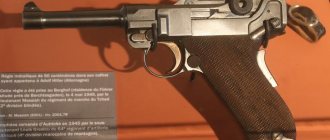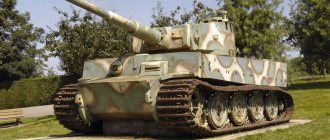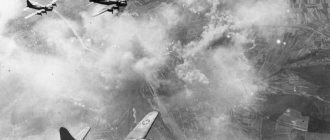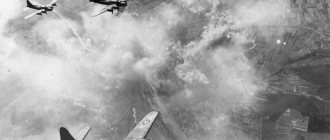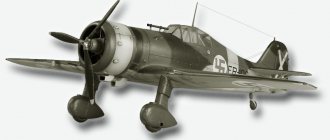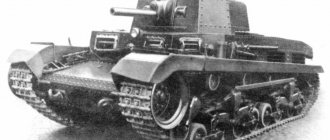(8 RAD).
The basic chassis of the armored car was developed, mass production began in 1938 and continued almost until the end of the war. All 8 wheels of this chassis are driven and steered and are partially covered with armor. The long body of a multifaceted shape is formed by rolled armor plates arranged with a direct and reverse slope.
The armored car was produced in the following modifications:
- reconnaissance armored vehicle with a 20-mm cannon (special vehicle 231);
- reconnaissance armored vehicle with a 20-mm cannon and a radio station with a frame-type antenna (special vehicle 232);
- reconnaissance armored vehicle with a 75-mm howitzer with a 24-caliber barrel (special vehicle 233);
- machine for radio communication with a frame-type antenna (special machine 263).
Armored car Sd.Kfz.231 (8-rad).
In 1944, the armored car was modernized and on its basis the 234 family of special vehicles was created:
- reconnaissance armored vehicle with a 20-mm cannon capable of firing at aircraft (special vehicle 234/1);
- reconnaissance armored vehicle "Puma" with a 50-mm cannon with a 24-caliber barrel (special vehicle 243/3);
- reconnaissance armored vehicle with a 75 mm anti-tank gun with a barrel length of 48 calibers (special vehicle 234/4)
| Preserved armored vehicles in museums around the world | |
| Sd.Kfz.231 (8-rad) – Wehrtechnische Studiensammlung Koblenz (Germany) | Sd.Kfz.234/3 – Bovington Tank Museum (UK) |
| Sd.Kfz.234/4 – Munster Panzer Museum (Germany) | Sd.Kfz.234/4 – Patton Museum, Fort Knox, KY (USA) |
| click on the photo of the armored car to enlarge | |
Depending on the modification, heavy armored vehicles were used in heavy armored vehicle companies of reconnaissance battalions of tank and motorized divisions, infantry support units, and radio platoons of headquarters units at all levels.
Armored car Sd.Kfz.231 (8-rad).
Tactical and technical characteristics of armored vehicles.
234/1
| Type | Sd.Kfz.234/1 |
| Crew | 4 |
| Length, mm | 5860 |
| Width, mm | 2330 |
| Height, mm | 2100 |
| Ground clearance, mm | 350 |
| Dry weight, kg | 5800 |
| Combat weight, kg | 11500 |
| Speed, km/h | 90 |
| Cruising range, km | 1000-600 |
| Fuel consumption, l per 100 km | 40-60 |
| Turning radius, m | 14,9 |
| Slope, ° | 30 |
| Wall, mm | — |
| Brod, mm | 1200 |
| Ditch, mm | 2000 |
| Armor, mm | 10-30 |
| Engine power, hp | 210 |
| Interaxle base, mm | 1300+ 1400 + 1350 |
Heavy armored cars of the Sd.Kfz family. 231 8-Rad
In the first half of the thirties, Nazi Germany began to openly violate all international treaties limiting the production of weapons and military equipment. The Nazis were preparing for war and tried to equip the army with the latest technology as quickly as possible. Thus, in the mid-thirties, the German automotive industry introduced the Schwerer Panzerspähwagen 6-Rad armored car, also known under the designation Sd.Kfz. 231. The main requirement from the customer was to ensure maximum use of parts, components and assemblies of existing trucks. A characteristic feature of the project was the unified armored hull and its internal equipment. The chassis of a specific Sd.Kfz. 231 6-Rad, in turn, depended on the manufacturing plant. Bussing-NAG, Daimler-Benz and Magirus have modified the chassis of their production trucks, on which a single armored hull was installed.
Schwerer Panzerspähwagen 6-Rad
Thanks to the original approach to creating the chassis, it was possible to relatively quickly establish mass production of the new armored car. However, the total number of six-wheeled vehicles was limited to just over 120 units. The reason for this was simple: the modified chassis of civilian trucks could not withstand the heavy weight of the armor and lost acceptable driving characteristics, including cross-country ability. Due to a number of fundamentally fatal design flaws of the Sd.Kfz. 231 6-Rad in 1934, the Wehrmacht demanded that a new heavy armored vehicle be designed from scratch, albeit using off-the-shelf components. The new technical specifications provided for equipping the armored car with all-wheel drive and an engine whose power would be sufficient for movement over rough terrain.
In accordance with the competition task, Bussing-NAG developed a special four-axle chassis with an 8x8 wheel arrangement. The project received the corporate designation Schwerer Panzerspähwagen 8-Rad and the army designation Sd.Kfz. 231 8-Rad. To avoid confusion with the previous armored car, which, according to initial plans, was to some extent become a prototype of the new one, it was necessary to introduce an additional index into the names of both vehicles indicating the number of wheels (8-Rad and 6-Rad). The eight-wheeled chassis turned out to be interesting and promising in technical terms, but still quite complex, which later affected the pace of production.
Armored body of the Sd.Kfz vehicle. 231 8-Rad was based on a welded T-profile frame. Sheets of armor were bolted to it. The thickness of the hull armor varied from 5 millimeters on the bottom to 15 mm on the upper frontal plate. The design of the tower was similar to the structure of the main hull - a frame and armor plates attached to it. The tower was mounted on the hull using a ball bearing of the appropriate size. In the tower Sd.Kfz. 231 8-Rad, an original solution was used, which had not previously been used on armored vehicles: a special structure with a fighting compartment floor was placed under the turret. Thanks to this innovation, it was possible to significantly facilitate the combat work of the crew members located in the turret; in particular, now they could not change their position when aiming weapons horizontally.
Internal volume of the Sd.Kfz. 231 8-Rad was divided into two parts: the combat and engine compartments. The first was located in the front of the armored car, it contained workplaces for four crew members. The MTO, in turn, was placed in the rear of the hull. The basis of the power plant was a Bussing-NAG L8V-GS gasoline carburetor engine, which developed power up to 150 horsepower. The engine torque was transmitted through a dry clutch to a gearbox that had three forward and reverse speeds. Especially for driving on rough terrain, the Sd.Kfz. 231 8-Rad was equipped with a special gearbox. Subsequently, new modifications of the armored car received new engines and an updated transmission. At the same time, the suspension of the cars remained practically unchanged from variant to variant. All eight wheels were suspended using two pendulums each, between which an axle shaft passed. The problem of depreciation was solved in a rather original way. The upper pendulums of the wheels of one axle were connected to each other through a spring. This made it possible to save space and sprung two wheels at once with one part. Actually the wheels of the Sd.Kfz armored car. The 231 8-Rads were pressed from sheet steel and fitted with Continental 210x18 low-pressure tires. The surface of the wheel tubes was covered with a rubber sheet, which compensated for punctures and damage. In practice, the wheel could be operated with six holes.
The basis of the weapons of the Sd.Kfz. 231 8-Rad had a 20 mm 2 cm KwK 30 L/55 gun, or the later KwK 38 L/55. The automatic rifled gun had 200 rounds of ammunition and could fight lightly armored targets and poorly protected shelters. The gun was paired with a 7.92 mm MG34 or MG42 machine gun with 1,300 rounds of ammunition. The cannon and machine gun could be aimed within the range from -10° to +26° in the vertical plane and in a circle in the horizontal plane. Interestingly, if necessary, the crew could fire from a machine gun and from a high elevation. After manipulating the machine gun lock, its vertical aiming angle increased to +37°, but the possibility of simultaneous aiming of coaxial weapons was lost. Aiming was carried out through the TZF6 optical device.
In its original equipment, the heavy armored car Sd.Kfz. 231 8-Rad had a combat weight of 8300 kg. This was quite a lot for such a vehicle, but the 150-horsepower engine and good chassis ensured good driving performance. So, on the highway the armored car accelerated to 90-100 kilometers per hour and could travel about three hundred kilometers on one gas station. Cross-country ability Sd.Kfz. 231 8-Rad was as follows: the car climbed a slope of up to 30°, overcame half-meter walls, forded water obstacles up to a meter deep and crossed ditches up to 1.2-1.3 meters wide. As noted in the test report of the armored car, its maneuverability was no worse than that of some tanks of that time. Having received a lot of positive feedback, the new armored vehicle was put into service in 1937. In the shortest possible time, a good armored car Sd.Kfz. 231 8-Rad ousted its “ancestor” Sd.Kfz from the army units. 231 6-Rad. Three-axle vehicles were gradually decommissioned from the Wehrmacht and transferred to police units, where they served until their service life expired.
Already during the first months of operation of the new armored car, nicknamed by the troops Achtrad (“Eight-wheeled”), its good potential not only as an armored vehicle, but also as a light wheeled tank became clear. For this reason, over the course of a couple of years, several modifications were created that differed from the original vehicle in terms of equipment, weapons, etc. The list of versions of the “Eight Wheel” looked like this:
Sd.Kfz. 231 8-Rad
. The main modification on the basis of which all others were assembled. It was manufactured from 1937 to 1942, when it was considered obsolete and discontinued in favor of new modifications.
Sd.Kfz. 232
. It differs from the original armored vehicle in the presence of a FuG11 SE30 radio station and a loop antenna. Since 1941, armored cars of this modification were equipped with a FuG12 SE80 radio. The antenna remains the same.
Sd.Kfz. 233
. Armored cars of this model went into service with the troops in 1942. The turret was removed from the base vehicle, and a short-barreled 7.5 cm Sturmkanone 37 L/24 gun with small aiming angles was installed in the vacant space. The rest of the armored vehicle's weapons and equipment did not change significantly.
Sd.Kfz. 263
. Further development of Sd.Kfz. 231 towards the creation of a full-fledged communication machine. Instead of a rotating turret, this modification received a relatively large stationary armored cabin. On the roof of the hull and the wheelhouse there were racks for several antennas connected to radio stations inside the hull. Defensive weapons consisted of one machine gun.
Sd.Kfz. 234/1
. In 1944, a major modernization of the armored car was carried out with the replacement of the engine, increasing the thickness of the hull plates, etc. So, the frontal sheet now had a thickness of 30 millimeters. The basis of the power plant was the 12-cylinder Tatra-103 engine with a maximum power of 210 hp. Taking into account operating experience, the chassis was slightly strengthened and the tires were replaced. Inherited from Sd.Kfz. 231 new armored vehicles received a turret with a 20-mm cannon and a coaxial machine gun, but with a new armored mantlet.
Schwerer Panzerspähwagen (5cm) Sd.Kfz. 234/2 "Puma" in France, on the eve of the Allied landings
Sd.Kfz. 234/2 Puma
. The thoroughly redesigned armored car "234/1" became the basis for several new armored vehicles for various purposes. Its first modification was the Sd.Kfz. 234/2 Puma. In fact, it was a heavy armored car of the previous model, but with a new turret and weapons. The Puma turret was larger and was armed with a 50 mm 5 cm KwK 39 L/60 cannon. An MG42 machine gun with several belts of 1050 rounds was paired with it. Vertical guidance of the weapon could be carried out within the range from -10° to +20°. The Puma turret was equipped with two three-barrel smoke grenade launchers of 90 mm caliber.
Sd.Kfz. 234/3
. Further development simultaneously Sd.Kfz. 233 and Sd.Kfz. 234/1. Instead of a turret, relatively low sheets of armor were mounted on the hull of the latter, forming a wheelhouse. A 75-mm 7.5 cm KwK K51 cannon was mounted on the front deckhouse, the ammunition capacity of which was 50 rounds. The mounting system made it possible to point the gun within 12° to the sides in the horizontal plane and within the range from -10° to +12° vertically. The relatively large volume of the fighting compartment of the self-propelled armored car made it possible to simultaneously transport up to 1950 rounds of ammunition for the MG42 machine gun. Instead of smoke grenade launchers, smoke bombs with a remote fuse were placed on the hull.
Sd.Kfz. 234/4
. Anti-tank armored vehicle. Based on the turret of previous armored cars, a new fixed wheelhouse was designed. It was equipped with a 75-mm PaK 40 L/46 anti-tank gun. The firing sector in the horizontal plane was similar to the same parameter for the Sd.Kfz. 234/3, and vertical aiming was carried out in the sector 3-22 degrees from the horizontal. Equipment, additional weapons, etc. remained the same.
ADGZ
. The latest representative of the family of armored cars based on the Sd.Kfz. 231 8-Rad became the ADGZ car. It was quite different from other armored vehicles and therefore, despite its direct origin from the Sd.Kfz. 231, is often considered as a separate development. An Austro Daimler M612 engine with 150 horsepower was installed in the ADZG engine compartment. For some reasons, on this modification only four wheels from the second and third pairs were driven. At the same time, to ensure proper grip on the surface, two wheels were installed on the second and third axle shafts instead of one. The main armament of the ADGZ was a 20 mm 2 cm KwK35 L/45 automatic cannon in a rotating turret. It is worth noting that the gun was mounted in a rotating installation, which was uncharacteristic for such weapons. The gun was installed in the right half of the turret. The left one was used for the MG34 machine gun in a similar ball mount. In addition to turret rotation, the ball mounts provided additional guidance within a 20° wide sector in the horizontal plane. Vertical aiming angles – from -12° to +18°. Unlike all previous armored vehicles of the family, the ADGZ could fire at two targets simultaneously.
All armored vehicles of the Sd.Kfz family. 231 8-Rad had a chassis of a similar design, which is why they had equally good maneuverability, which almost did not deteriorate with increasing combat weight. At the same time, the pendant was quite difficult to manufacture. As a result, no more than two thousand armored cars of all models were assembled. The most successful in terms of quantity was the original Achtrad, which was released in a “circulation” of more than 1,200 units. Other machines shared the remaining production volumes in varying proportions. One of the main reasons for this was the very complexity of the suspension: in peacetime, the production of Sd.Kfz was established. 231 8-Rad, but during the war it was no longer possible to launch mass assembly of new models.
The combat use of all armored cars was limited to supporting the infantry in the offensive and covering it with their fire. Modifications armed with 75-mm guns were repeatedly used in the fight against tanks, but due to the relatively weak armor, attempts to use armored cars as tank destroyers quickly ceased. The greatest success of Sd.Kfz. 231 8-Rad and its “followers” reached North Africa, where the cross-country ability of the eight-wheeled chassis made it possible to effectively conduct combat operations in conjunction with tracked armored vehicles. Despite all the successes and the totality of combat characteristics, by the middle of World War II, Achtrad armored cars became an insufficient combat weapon. Because of this, their use was gradually reduced and their main task became escorting convoys, accompanying troops on the march and other actions not related to direct confrontation with the enemy. Several examples of German heavy armored vehicles have survived to this day, most of them belonging to the Sd.Kfz family. 234.
Throughout the Second World War, armored cars Sd.Kfz. 231 8-Rads fell into Allied hands. Some of these trophies were in fairly good condition and were used for testing. Testers in the Soviet Union, Great Britain and the United States recognized the positive aspects of the original chassis design. However, the views of the military of that time were directed towards tanks and self-propelled artillery units. Armored vehicles, including heavy ones, began to be considered a kind of anachronism. For this reason, the following armored wheeled vehicles were representatives of the "armored personnel carrier" class. Nevertheless, the interesting layout of the chassis with two levers interested the designers of the countries of the anti-Hitler coalition. It is noteworthy that similar ideas, for example, existed in our country before, but simply did not find mass application. German experience has shown that two levers and an axle shaft between them is a promising and interesting system. Perhaps it was thanks to the trophies that the Soviet armored personnel carrier BTR-60 received a similar suspension. At the same time, it is only similar to the chassis of the Sd.Kfz. 231 8-Rad. The fact is that these armored vehicles have different suspension systems. The German armored car used leaf springs, one per axle, and the Soviet armored personnel carrier was equipped with an interesting system of torsion bars and hydraulic shock absorbers.
Heavy reconnaissance armored vehicle Sd. Kfz. 232 schwerer Panzerspähwagen (Fu) (8-rad)
An American soldier near a damaged German armored vehicle Sd.Kfz.233 in Belgium. 1944
In the foreground is an Sd.Kfz armored car. 233. In the background, a captured French light tank Hotchkiss H39 unfolds
Heavy armored car Sd.Kfz. 231 (8-Rad) reconnaissance battalion of one of the Wehrmacht tank divisions, destroyed by Polish artillery
German heavy fire support BA Sd Kfz 234/3 and Sd Kfz 234/4
The latest representative of the family of armored cars based on the Sd.Kfz. 231 8-Rad became the ADGZ car
Based on materials from the sites: https://pro-tank.ru/ https://armor.kiev.ua/ https://apeiron-games.ru/
234/2
| Type | Sd.Kfz.234/2 |
| Crew | 4 |
| Length, mm | 6800 |
| Width, mm | 2330 |
| Height, mm | 2380 |
| Ground clearance, mm | 350 |
| Dry weight, kg | 5900 |
| Combat weight, kg | 11750 |
| Speed, km/h | 90 |
| Cruising range, km | 1000-600 |
| Fuel consumption, l per 100 km | 40-60 |
| Turning radius, m | 14,9 |
| Slope, ° | 30 |
| Wall, mm | — |
| Brod, mm | 1200 |
| Ditch, mm | 2000 |
| Armor, mm | 10-30 |
| Engine power, hp | 210 |
| Interaxle base, mm | 1300+ 1400 + 1350 |
Technique
The vehicle's architecture was classic for trucks of the time, with three rigid axles connected to the chassis by leaf spring suspension. Traction was transmitted only to the two rear axles. Night lights of the usual car type, so they were not obstructed, were mounted near the nose on the front fenders.
The engine (always running on petrol) was typically a 6-cylinder Daimler Benz M 09 and produced 68 bhp, however cars produced at other plants used the G model with a 4-cylinder petrol engine (65 bhp). ) from Büssing-NAG or 88 6.-cylinder (70 hp) Magirus.
The armament was located in the turret and included a cannon (in post-World War II terminology it was referred to as a machine gun). 2 cm KwK 30 (and subsequently 2 cm KwK 38) and the MG 13 coaxial machine gun, later replaced by the MG34. An additional MG34 could be mounted on the roof of the anti-aircraft turret.
Protection was provided by 14.5 mm thick sheets with good ballistic slope and fully welded. The armored hull was built by the Deutschen Werke of Kiel or the Deutschen Edelstahlwerke of Hannover. The radiator was protected by grill panels that could be kept open during normal loadout or closed in combat. Access was provided by a door that hinged on the side, and, as was common on military equipment of the time, there were several hooks on the sides of the structure for various tools.
234/3
| Type | Sd.Kfz.234/3 |
| Crew | 4 |
| Length, mm | 5860 |
| Width, mm | 2330 |
| Height, mm | 2213 |
| Ground clearance, mm | 350 |
| Dry weight, kg | 5800 |
| Combat weight, kg | 11500 |
| Speed, km/h | 90 |
| Cruising range, km | 1000-600 |
| Fuel consumption, l per 100 km | 40-60 |
| Turning radius, m | 14,9 |
| Slope, ° | 30 |
| Wall, mm | — |
| Brod, mm | 1200 |
| Ditch, mm | 2000 |
| Armor, mm | 10-30 |
| Engine power, hp | 210 |
| Interaxle base, mm | 1300+ 1400 + 1350 |
Development
Development of this armored car began even before the takeover of the Nazi regime, as it leaned against the center of Kazan in the Soviet Union, since the Treaty of Versailles significantly limited the development of military equipment in Germany (only armored cars were allowed to be built to maintain public order, and each series had to be approved in the model and the number of the control commission), the German authorities agreed with foreign states on this. develop their own military vehicles, and also transfer technology to these countries, usually less advanced than Germany in the field of war.
Among the many vehicles tested secretly in Kazan was an 8x8 armored car ( Mannschafts Transportwagen I
), which, however, proved too difficult to put into production due to its high cost. On the other hand, several 6x4 truck models were developed simultaneously for military use, produced by Daimler-Benz (G 3 and G 3a), Magirus (M 206) and Büssing (G 31), so it was decided to transform this into an armored car model G 3a (from Daimler-Benz, designed by Porsche engineer).
To adapt the truck chassis to an armored personnel carrier, some modifications were required, namely strengthening the front axle, increasing the radiator cooling area, and transforming the steering so that reversing would also be possible. Maybe. (dual steering) and wider tire usage to increase the vehicle's off-road capabilities. The armored car went into production in 1932 and this continued until 1935. A total of a thousand cars were produced.
234/4
| Type | Sd.Kfz.234/4 |
| Crew | 4 |
| Length, mm | 6840 |
| Width, mm | 2330 |
| Height, mm | 2350 |
| Ground clearance, mm | 350 |
| Dry weight, kg | |
| Combat weight, kg | 11550 |
| Speed, km/h | 90 |
| Cruising range, km | 1000-600 |
| Fuel consumption, l per 100 km | 40-60 |
| Turning radius, m | 14,9 |
| Slope, ° | 30 |
| Wall, mm | |
| Brod, mm | 1200 |
| Ditch, mm | 2000 |
| Armor, mm | 10-30 |
| Engine power, hp | 210 |
| Interaxle base, mm | 1300+ 1400 + 1350 |


